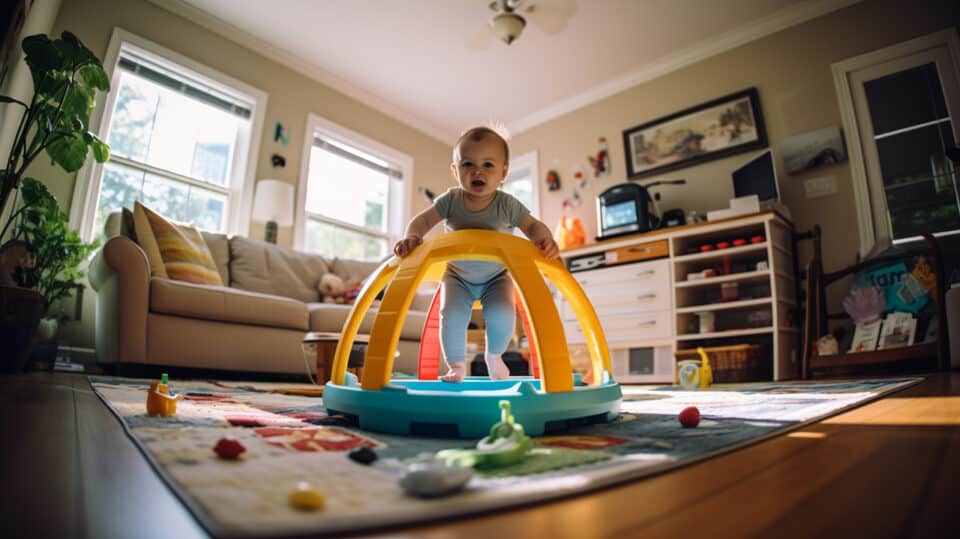Juggling the sea of baby equipment options, you may often wonder what’s best for your little one’s motor skill development. Trust me, I’ve been there too! However, learning that varied stimulation and different positions are critical to a child’s growth pushed me to dig deeper into this topic.
In this insightful piece, we’re going to unpack how baby jumpers impact your darling’s motor skills and explore safer alternatives at length. Ready for an eye-opening journey?
Key Takeaways
Baby jumpers can be beneficial for motor skill development as they allow babies to strengthen leg muscles, improve coordination, and provide sensory stimulation.
However, prolonged use of baby jumpers may restrict varied stimulation and different positions needed for learning useful movements, potentially delaying the development of certain motor skills like sitting, crawling, and walking.
It is important for parents to use baby jumpers responsibly under supervision and for limited periods of time. They should not rely solely on baby jumpers but also incorporate other activities like floor play, tummy time, and free movement to promote a well-rounded set of motor skills in their child.
Table of Contents
Understanding Motor Skill Development in Babies
Motor skills refer to the ability to control and coordinate movements of the body, such as reaching, grasping, sitting, crawling, and walking.
Definition of motor skills
Motor skills are the fundamental building blocks of your child’s physical growth and future independence. These abilities include everything from tiny motions like picking up crayons to large ones such as jumping or running.
They’re divided into fine motor skills, which involve small movements requiring precision – think grasping a spoon or buttoning clothes; and gross motor skills, which use larger muscles for actions like crawling, walking, or throwing a ball.
The development of these skills depends on both muscle strength and brain growth. So when I say we need to work on motor skills, what I mean is fostering an environment where your baby can strengthen their little muscles while also learning how their body moves in space!
Importance of motor skills in babies
As a mom, developing your baby’s motor skills is crucial. It’s not just about crawling or walking; these skills form the groundwork for all tasks your child will perform throughout their life.
These abilities are essentially divided into two sections: gross and fine motor skills. Gross motor skills are larger movements involving arms, legs, feet, or the entire body, like crawling, running, and jumping.
Fine motor skills are smaller actions such as grasping an object between the thumb and finger or using lips and tongue to taste objects. Each habiliment contributes to your little one’s overall strength development, sensory stimulation, muscle control – even cognitive skills! With these skills well-developed in the first year of life, they get a headstart on everything from eating with utensils to learning how to write when they start school.
Baby Jumpers and Motor Skill Development

Baby jumpers are devices that allow babies to bounce while suspended in a fabric seat attached to an elastic cord or springs. They provide a fun and interactive way for babies to develop their motor skills.
What is a baby jumper?
A baby jumper, simply put, is a piece of equipment designed to stimulate and encourage childhood development as well as motor skills. It’s a fun-filled activity center your babies can hop into; they are safely secured in an upright position with their toes touching the surface.
The real magic happens when your little ones start bouncing or pushing off the floor with their toes. This action triggers laughter, joy, and heaps of excitement for them while simultaneously promoting strength development in their developing leg muscles.
However, like any other baby gear, it shouldn’t be used for prolonged periods due to potential developmental concerns, which we’ll delve into later in this blog series. Rest assured, though, that when used responsibly under supervision, it can become part of your arsenal in supporting your babies’ journey toward mastering motor skills!
How do baby jumpers assist in motor skill development?
Baby jumpers can play a significant role in promoting motor skill development in infants. These devices allow babies to experience bouncing movements, which helps them strengthen their leg muscles and improve coordination.
The repetitive bouncing motion also supports the development of balance and posture control as babies learn to stabilize themselves while jumping. Additionally, baby jumpers provide sensory stimulation through the use of toys and interactive features, encouraging babies to reach for objects and enhance their fine motor skills.
It’s important to remember that while baby jumpers can be beneficial, they should be used under supervision and for limited periods of time to ensure overall healthy motor development.
Comparison: Baby Jumpers, Exersaucers, and Walkers
Baby jumpers, exersaucers, and walkers are all popular baby equipment designed to assist in motor skill development.
Pros and cons of each
As a mother, it’s crucial to fully understand the upsides and downsides of each baby product, particularly when it comes to its impact on your little one’s motor skill development. Let’s break down the benefits and potential drawbacks of baby jumpers, exersaucers, and walkers:
| Product | Pros | Cons |
| Baby Jumpers | Baby jumpers can offer entertainment and allow babies to exercise their legs. They can also help strengthen pre-walking muscles and provide sensory information from the feet. | The downside is that exersaucers may not encourage active sitting or provide accurate posture signals due to their molded seats. It’s also worth noting that crawling, a vital developmental step, is often skipped when using exersaucers. |
| Exersaucers | Exersaucers provide a safe space for babies to play and explore. They can also offer a variety of activities that engage a baby’s senses and foster motor skill development. | The downside is that exersaucers may not encourage active sitting or provide accurate posture signals due to their moulded seats. It’s also worth noting that crawling, a vital developmental step, is often skipped when using exersaucers. |
| Walkers | Walkers can provide support for babies who are learning to walk, making them feel independent. They may also offer amusement and serve as an exercise tool. | Unfortunately, walkers can pose a serious injury risk due to potential falls. Moreover, like baby jumpers, walkers may limit the necessary varied stimulation and positions for motor skill development. |
While there are potential benefits to each of these products, it’s wise to use them in moderation and not as a replacement for floor play, tummy time, and other recommended activities that encourage movement and exploration.
Impact on motor skill development
As parents, we want to do everything we can to help our babies develop their motor skills. Baby jumpers can be a fun and engaging way for babies to strengthen their muscles and improve coordination.
When used correctly and in moderation, baby jumpers can have a positive impact on motor skill development. Babies can bounce up and down, which helps build strength in their leg muscles.
They also learn how to maintain balance while jumping, which contributes to their overall coordination. However, it’s important to remember that baby jumpers should not be relied upon as the sole source of movement for your little one.
The Controversy Surrounding Baby Jumpers

There is ongoing controversy surrounding the use of baby jumpers due to concerns about their impact on motor skill development.
Concerns about baby jumpers
I have some concerns about baby jumpers that I want to share with you. Here are the reasons why I believe parents should approach baby jumpers with caution:
- Safety risks: Baby jumpers involve suspending babies in a seat, which can be risky if not used properly. There is a risk of falls and collisions with furniture or other objects in the room.
- Incorrect posture: Baby jumpers may not promote proper posture. They do not allow babies to actively engage their core muscles and learn to sit up on their own, which is essential for developing good seated posture.
- Delayed motor skill development: Some studies suggest that the use of baby jumpers can actually delay the development of certain motor skills, such as sitting, crawling, and walking. Babies need varied positions and freedom of movement to learn these skills naturally.
- Lack of sensory stimulation: Baby jumpers restrict a baby’s movement and limit their exposure to different sensory experiences. In order for babies to understand their environment and develop their sensory map, they need to explore freely by moving different parts of their bodies.
- Overdependence on external support: Relying too heavily on external support like baby jumpers may hinder a baby’s ability to develop independent balance and coordination skills necessary for future milestones like walking independently.
Recent guidelines and recommendations
As a mother, it’s important to stay up to date with the latest guidelines and recommendations when it comes to our babies’ development. Here are some recent guidelines and recommendations regarding baby jumpers and their impact on motor skill development:
- The American Academy of Pediatrics advises against using baby walkers due to safety concerns. They state that baby walkers can lead to injuries and delays in motor development.
- The March of Dimes recommends avoiding the use of baby walkers altogether. They highlight the potential risks for falls, burns, drowning, and other accidents associated with using walkers.
- According to a systematic review published in the Iranian Journal of Child Neurology, the use of baby walkers was associated with developmental delay and an increased risk of injuries.
- A study conducted by researchers from Isfahan University of Medical Sciences found that stationary jumpers were safer than traditional door frame bouncers but still advised against prolonged usage due to potential adverse effects on motor development.
- Instead of relying on baby jumpers or walkers, experts recommend providing babies with ample floor time for play and exploration. This allows them to develop their motor skills naturally without the constraints or risks associated with jumpers.
- Baby gyms and play mats are great alternatives to jumpers as they provide a safe space for babies to move around, reach for toys, and practice their motor skills.
- Tummy time is crucial for strengthening neck muscles and developing head control in infants. It also helps promote crawling and other important milestones in motor development.
Alternatives to Baby Jumpers for Motor Skill Development

Some alternatives to baby jumpers for motor skill development include engaging in playtime activities, using baby gyms and play mats, and incorporating tummy time into daily routines.
Playtime activities
During playtime, there are many activities you can engage in with your baby to promote motor skill development. Here are some ideas:
- Encourage tummy time: Place your baby on their stomach to strengthen their neck, shoulder, arm, and trunk muscles. Gradually increase the duration of tummy time sessions to build strength and develop motor skills.
- Provide room to move: Allow your baby plenty of space on the floor to explore and move around. This promotes independent movement and supports motor skill development.
- Engage in interactive play: Play games such as peek-a-boo or pat-a-cake with your baby to encourage interaction and develop coordination.
- Use toys with different textures and colors: Toys that make noise or have different textures can make activities more exciting and engaging for babies, stimulating their senses as they explore and manipulate the toys.
- Involve siblings and other family members: Encourage siblings or other family members to interact with the baby during playtime. This not only fosters a sense of bonding but also enhances the baby’s engagement and motivation.
- Provide praise and encouragement: When your baby attempts something new or achieves a milestone, provide lots of praise and encouragement. It can be a significant motivator for them to continue exploring their motor skills.
Baby gyms and play mats
Baby gyms and play mats are excellent alternatives to baby jumpers for promoting motor skill development in babies. They provide a safe and stimulating environment for little ones to explore and move their bodies. Here are some important points to consider:
- Baby gyms and play mats offer a soft and comfortable surface for babies to practice rolling over, crawling, and eventually sitting up on their own.
- These play areas often come with colorful hanging toys, mirrors, and tactile elements that encourage sensory exploration and hand-eye coordination.
- The interactive features of baby gyms help stimulate the baby’s senses, fostering cognitive development and encouraging them to reach out and grab objects.
- Tummy time is an essential activity that can be easily facilitated by using a baby gym or play mat. This position helps develop neck, shoulder, arm, and trunk strength.
- Babies can also practice gross motor skills like pushing up on their arms or kicking their legs while lying on these play surfaces.
- Play mats with different textures can provide sensory stimulation through touch, enhancing the baby’s overall sensory skills.
- Babies can spend time on their backs or bellies on a soft mat without any restrictions, allowing them to freely explore their movements.
Tummy time
Tummy time is crucial for your baby’s development. It helps strengthen their neck, shoulder, arm, and trunk muscles, which are essential for rolling, crawling, and eventually walking.
By gradually increasing the duration of tummy time sessions, you can support your baby’s muscle development and motor skills. Letting them try and fail a few times before stepping in can also help with motor learning.
And don’t forget to make tasks slightly more challenging once they’ve mastered a skill – this will encourage them to progress to the next stage of their motor development. Using toys with different sounds, textures, and colors can make tummy time even more exciting for your little one!
Frequently Asked Questions Baby Jumpers’ Affect on Child Development
Can baby jumpers hinder motor skill development?
While baby jumpers can be fun for infants, there is evidence to suggest that excessive use of these devices can actually hinder the development of certain motor skills. It is important for parents to strike a balance and provide opportunities for their babies to explore different types of movement.
How do baby jumpers affect muscle strength?
Baby jumpers primarily provide support and restrict movement, which means that certain muscles may not be fully engaged or strengthened during use. This can have implications on overall muscle tone and development if relied upon excessively.
Are there any alternatives to baby jumpers for promoting motor skills?
Yes, there are alternative ways to promote motor skill development in infants without relying solely on baby jumpers. Some options include tummy time, floor play with age-appropriate toys, supervised exploration in a safe environment, and interactive activities with caregivers.
At what age should parents introduce their babies to baby jumpers?
It is generally recommended to wait until the infant has good head control and the ability to sit independently before introducing them to a baby jumper. This typically occurs around six months of age but may vary depending on the individual child’s developmental milestones. Read More.
Conclusion
In conclusion, while baby jumpers can provide entertainment for babies, parents need to be aware of their potential impact on motor skill development. It is important to remember that babies learn best through varied stimulation and different positions, so relying solely on a baby jumper may hinder the development of essential skills like sitting, crawling, and walking.
Instead, parents should focus on providing opportunities for active play and exploration in a safe environment to support their child’s motor skill development.


